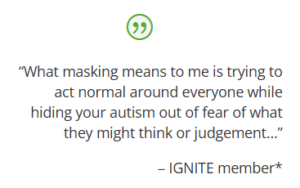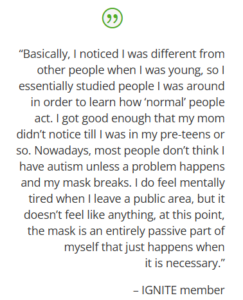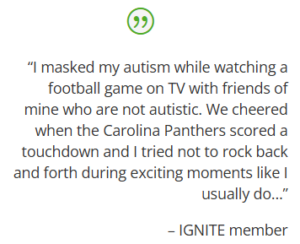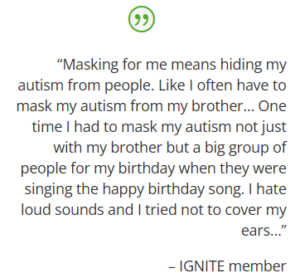Many autistic people and people with other neurodivergences (e.g., ADHD, Tourette’s) experience pressure to alter their natural ways of being to conform to neurotypical social expectations—a practice known as masking.
 Masking emerges from the pressure autistic people often face to modify their natural expressions and behaviors in response to neurotypical social expectations to “fit in.” This might manifest as suppressing natural movement patterns, adjusting communication styles, or managing sensory experiences without obvious accommodation. While some autistic people might choose to adapt their behavior in certain situations, masking frequently stems from external pressures and systemic ableism rather than genuine personal preference. The reality is that many individuals on the spectrum feel compelled to mask simply to access basic needs like education, employment, healthcare, and social connections.
Masking emerges from the pressure autistic people often face to modify their natural expressions and behaviors in response to neurotypical social expectations to “fit in.” This might manifest as suppressing natural movement patterns, adjusting communication styles, or managing sensory experiences without obvious accommodation. While some autistic people might choose to adapt their behavior in certain situations, masking frequently stems from external pressures and systemic ableism rather than genuine personal preference. The reality is that many individuals on the spectrum feel compelled to mask simply to access basic needs like education, employment, healthcare, and social connections.
The Impact of Forced Masking
The effects of sustained masking ripple through many aspects of an autistic person’s life. At its core, masking demands an enormous amount of cognitive and emotional energy—energy that could otherwise be spent on growth, creativity, or genuine connection. This constant expenditure of energy often leads to profound exhaustion and can culminate in burnout, particularly when masking is required day after day in work or educational settings.
 Beyond the immediate energy cost, forced masking can create a deep disconnect from one’s authentic self. When autistic people feel pressured to maintain different personas across various settings, opportunities for genuine self-expression become increasingly rare. This challenge extends to building meaningful relationships, as the energy spent on performance leaves little room for genuine connection.
Beyond the immediate energy cost, forced masking can create a deep disconnect from one’s authentic self. When autistic people feel pressured to maintain different personas across various settings, opportunities for genuine self-expression become increasingly rare. This challenge extends to building meaningful relationships, as the energy spent on performance leaves little room for genuine connection.
The impact extends beyond individual experiences to affect entire communities. When masking becomes an expected norm, it reduces the visibility of autistic experiences and perpetuates narrow behavioral expectations. This can create a cycle where neurotypical people have fewer opportunities to learn about and understand neurodiversity, while autistic people face continued pressure to conform to neurotypical standards.
Creating More Inclusive Spaces
Meaningful change begins with recognizing that the responsibility for inclusion lies not with autistic people changing themselves, but with transforming environments and social expectations to welcome neurodiversity. This transformation happens across multiple levels, from individual understanding to systemic change.
Within personal spheres, neurodivergent people benefit from opportunities to recognize and honor their natural ways of being. This might involve exploring what feels authentic versus what feels forced and making conscious choices about when and how to adapt behaviors based on personal preference rather than external pressure. Setting boundaries becomes an important tool for protecting one’s energy and authenticity.
 Communities play a crucial role in creating genuinely inclusive spaces. This involves actively challenging assumptions about “appropriate” behavior and implementing meaningful accommodations as standard practice. When spaces welcome diverse ways of being, they create opportunities for everyone to participate authentically and contribute their unique perspectives and strengths.
Communities play a crucial role in creating genuinely inclusive spaces. This involves actively challenging assumptions about “appropriate” behavior and implementing meaningful accommodations as standard practice. When spaces welcome diverse ways of being, they create opportunities for everyone to participate authentically and contribute their unique perspectives and strengths.
Educational settings and workplaces hold particular importance in this transformation. Rather than expecting autistic people to conform to rigid norms, these environments can adapt to welcome diverse communication styles, learning approaches, and ways of working. This might include creating sensory-friendly spaces, implementing flexible accommodation systems, and recognizing the value of different working styles.
Moving Forward
Creating truly inclusive spaces requires a fundamental shift in how we think about diversity in human cognition and behavior. Rather than viewing autistic traits as something to be hidden or changed, we can recognize and celebrate the natural variation in human neurology and expression.
This shift manifests in practical ways: implementing meaningful accommodations as standard practice, challenging ableist assumptions and behaviors, supporting autistic leadership, and creating environments where everyone can participate authentically. The goal isn’t to eliminate differences but to create spaces where differences are welcomed and valued.
 We must remember that while some people on the spectrum might choose to adapt their behavior in certain situations, authentic self-expression should never come at the cost of basic acceptance and access to community life. Through increased understanding and active inclusion, we can build communities that truly welcome and support autistic ways of being.
We must remember that while some people on the spectrum might choose to adapt their behavior in certain situations, authentic self-expression should never come at the cost of basic acceptance and access to community life. Through increased understanding and active inclusion, we can build communities that truly welcome and support autistic ways of being.
The path forward involves ongoing learning, listening to autistic voices, and taking concrete actions to create more inclusive spaces. When we focus on changing environments rather than people, we move closer to a world where everyone can fully participate as their authentic selves.
Personal Points of View
Jordan Birkner, ASNC Registered Behavior Technician, Behavioral Health Researcher and Advocate shares her experience with masking as an individual with autism:
“Masking has been a complex subject for me as in itself, I do not find it inherently harmful, but it is associated with harm. Like many things, it is a tool which has potential to impact others, and people are the ones that create the conditions where masking has negative consequences for me. In times where I know the stress will imbalance negatively for me in not conforming to these social expectations, such as a movie theater or a library, I mask in the same ways non-autistic people mask by trying to remain quiet and still out of consideration for the social group. However, when I face bullying or criticism for autistic traits in public situations, it creates conditions where masking is necessary all the time to remain comfortable and safe. It takes a large amount of focus and energy from my actual tasks when attempting to “blend in” to avoid these negative consequences. If the social ridicule and judgment was removed, I wouldn’t have to put in this amount of conscious effort as frequently as I do, and I could choose masking as a useful skill.”
Cindy Martin, ASNC Autism Resource Specialist believes “masking is a very common technique for autistic individuals to make them hide into the background and fit into the norms of society.” A mother of four autistic individuals, Cindy has repeatedly heard that her kids ‘don’t look autistic.’ It happens so often it has become a joke in her family that it must have to do with the shirt they wore that day. Cindy further shares her experiences with and insights about masking:
“The reality is that when society doesn’t ‘see’ the diagnosis, they don’t acknowledge the diagnosis. I remember my older son doing all the things necessary to fit in. He wanted to wear all the current clothing trends, get a job at the place where all the other high schoolers were working, attend all the school functions, but on the inside, he was emotionally spinning.
He had to tolerate loud noises in the halls at school, his teachers placed high demands on him because he was so academically gifted, his place of employment was an entertainment facility with bright lights, loud noises, high foot traffic, and a constant interaction with the public. By the time he came home at the end of the day, he was so overstimulated that he couldn’t maintain a conversation with me. He would often just lay his head on my shoulder and have me rub his head for the sensory input.
Masking is not just something that occurs in older individuals, but it can start at a very early age. Our little ones are expected to do all the “normal” activities, whether in the home, in church, or in social interactions with peers.
I remember the first time another child recognized a difference in my youngest child at a local playground. My son was trying to engage in play with other children at the park, and I heard this child I’d never seen before say to my baby boy, ‘Why are you so weird? What’s wrong with you?’
I watched things change after that as my sweet innocent child try to ‘fit in’ when he was around peers. It took years after that for him to embrace his diagnosis and advocate for himself. He would often cry in my arms and yell that he hated autism. I knew we had to show him all the wonderful things about autism and exactly how special it made him.
As a society, we must learn that we are all different in our own unique ways. We must help others understand how amazing the autism journey is. We must show one another unconditional acceptance and we must educate. People don’t know what they don’t know, and our discussions should always include autism. We should share as much information as possible with the world. Autism is a beautiful word, and it should be used frequently.”
*The Autism of North Carolina (ASNC) IGNITE is a unique “peer-to-peer” community center for young adults with autism transitioning into adulthood. IGNITE offers activities and educational groups that foster independence and social interaction. Members work toward financial, educational, and employment success. The quotes above are attributed to different members of the ASNC IGNITE program. Learn more on our IGNITE webpage.
Tags: Masking autism Go back
